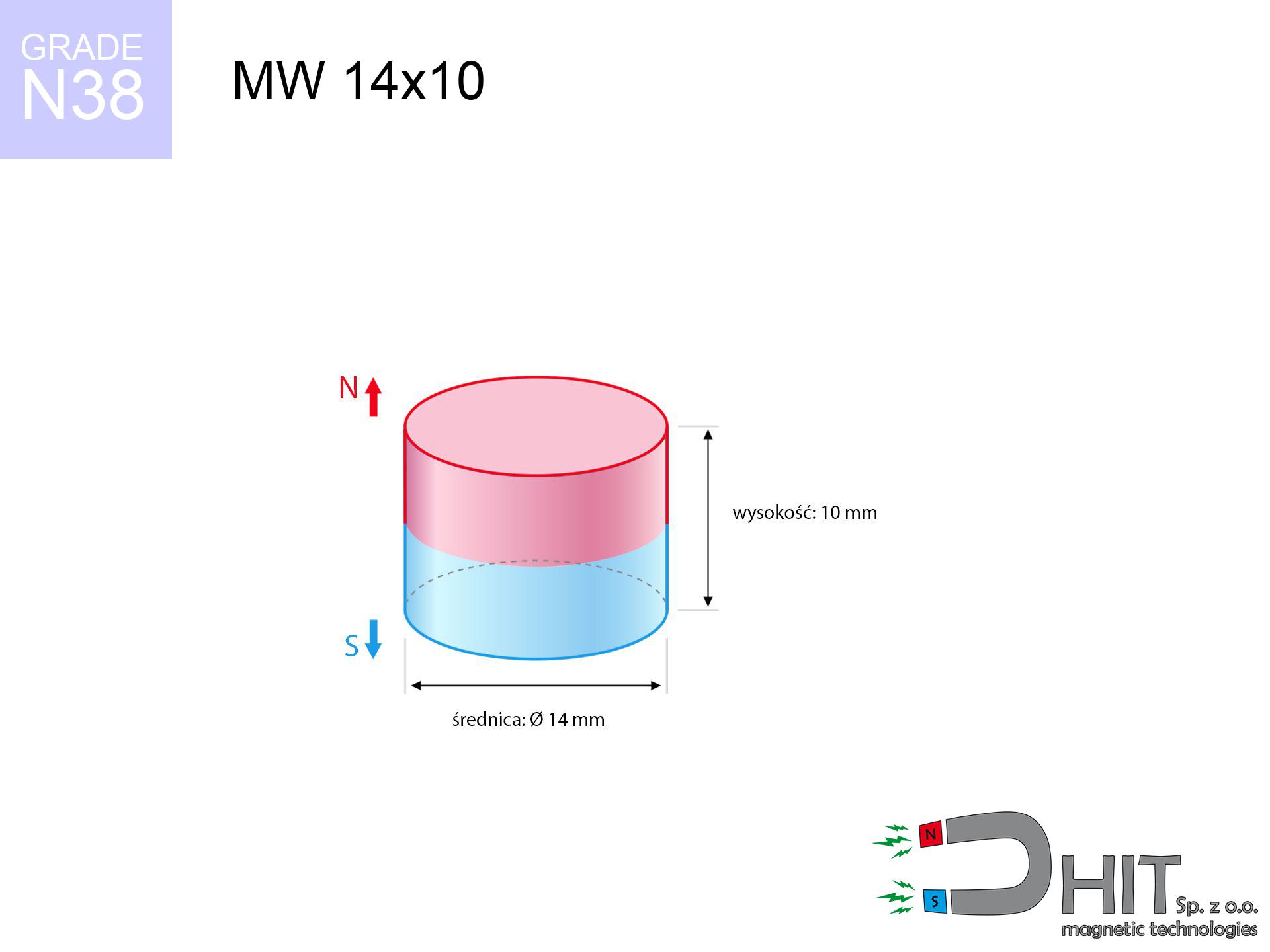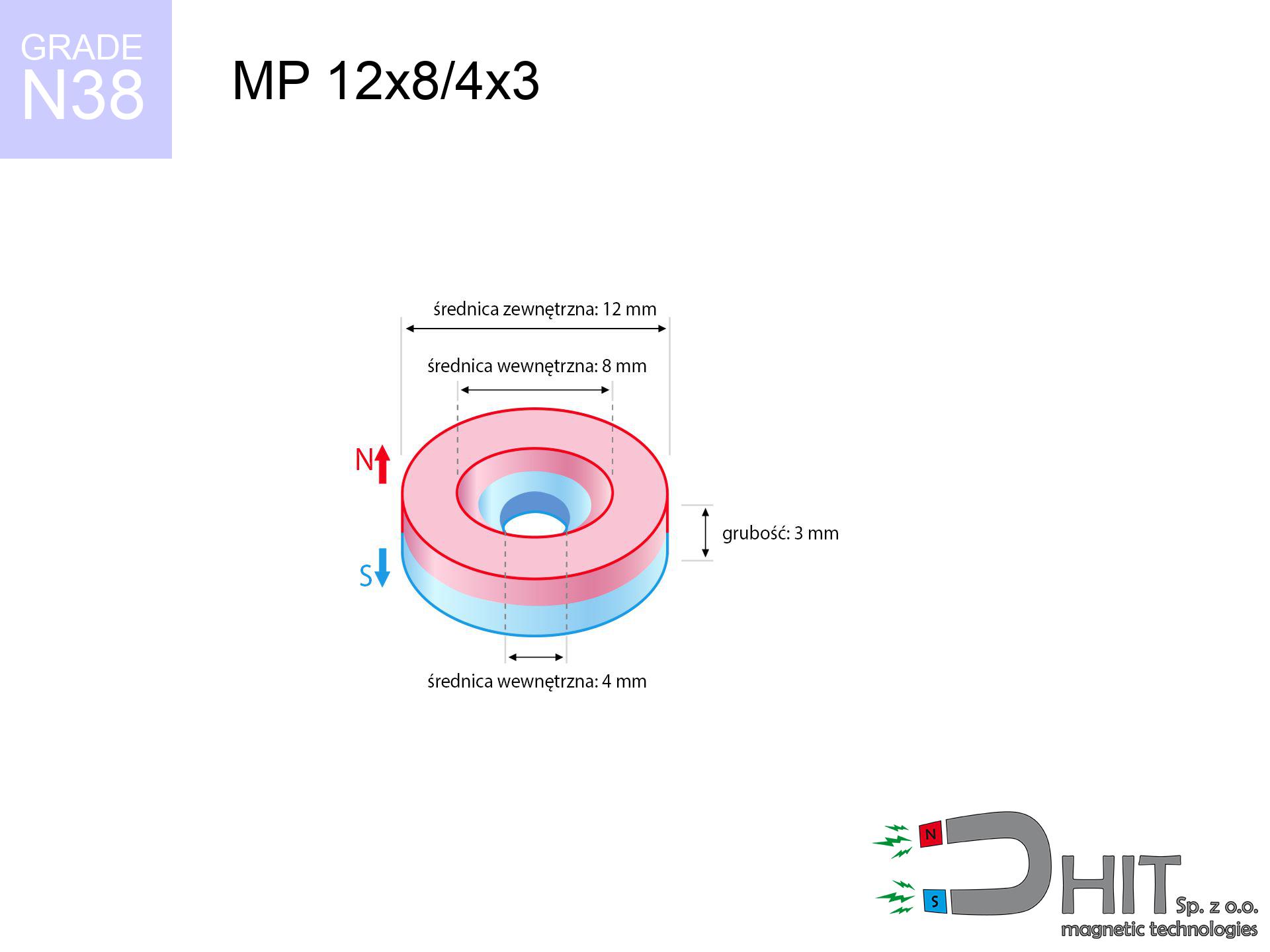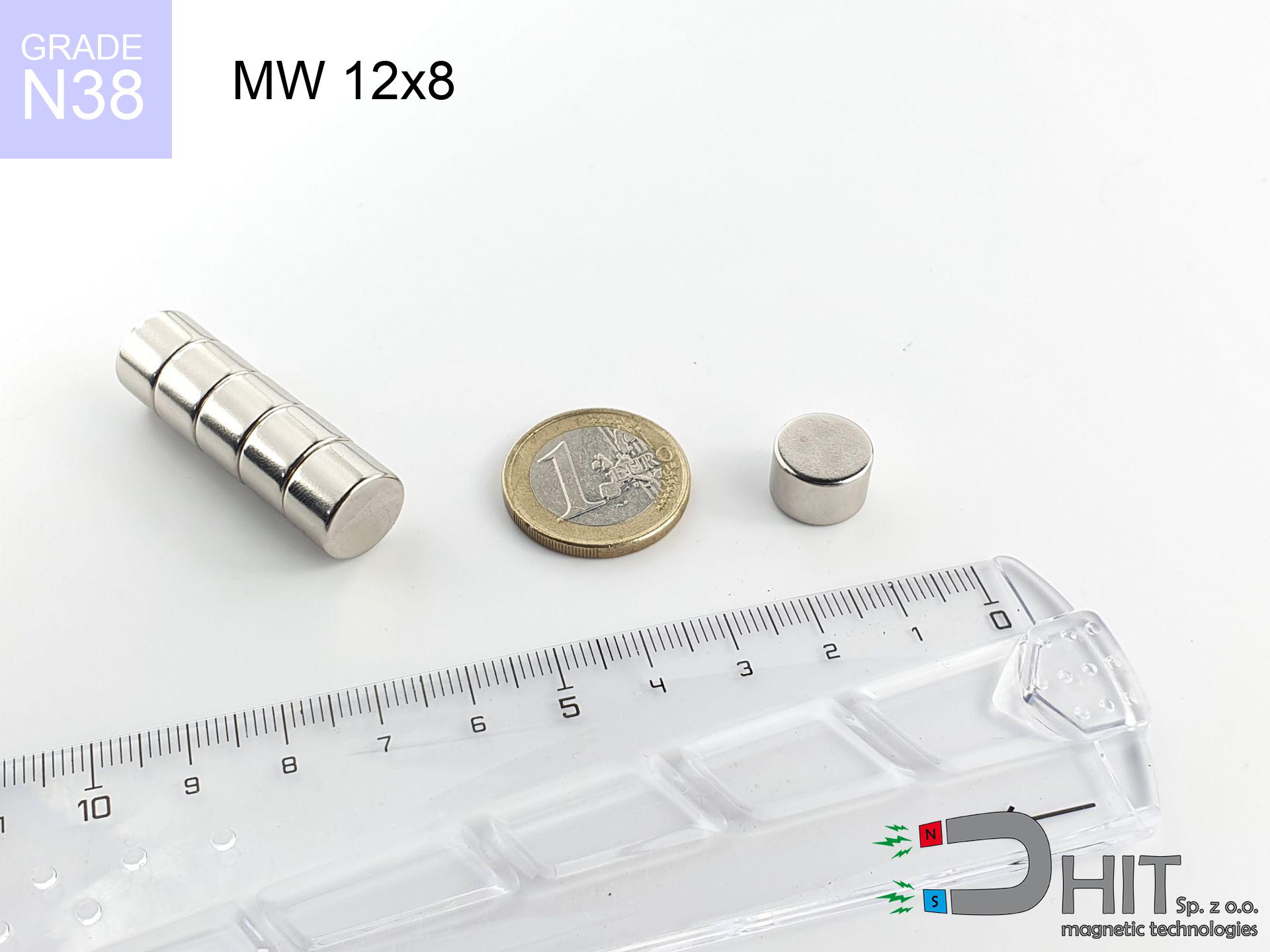MW 14x10 / N38 - cylindrical magnet
cylindrical magnet
Catalog no 010391
GTIN/EAN: 5906301811084
Diameter Ø
14 mm [±0,1 mm]
Height
10 mm [±0,1 mm]
Weight
11.55 g
Magnetization Direction
↑ axial
Load capacity
6.71 kg / 65.83 N
Magnetic Induction
507.48 mT / 5075 Gs
Coating
[NiCuNi] Nickel
6.84 ZŁ with VAT / pcs + price for transport
5.56 ZŁ net + 23% VAT / pcs
bulk discounts:
Need more?
Call us now
+48 22 499 98 98
or send us a note via
form
through our site.
Strength as well as shape of a magnet can be calculated with our
power calculator.
Orders submitted before 14:00 will be dispatched today!
Technical of the product - MW 14x10 / N38 - cylindrical magnet
Specification / characteristics - MW 14x10 / N38 - cylindrical magnet
| properties | values |
|---|---|
| Cat. no. | 010391 |
| GTIN/EAN | 5906301811084 |
| Production/Distribution | Dhit sp. z o.o. |
| Country of origin | Poland / China / Germany |
| Customs code | 85059029 |
| Diameter Ø | 14 mm [±0,1 mm] |
| Height | 10 mm [±0,1 mm] |
| Weight | 11.55 g |
| Magnetization Direction | ↑ axial |
| Load capacity ~ ? | 6.71 kg / 65.83 N |
| Magnetic Induction ~ ? | 507.48 mT / 5075 Gs |
| Coating | [NiCuNi] Nickel |
| Manufacturing Tolerance | ±0.1 mm |
Magnetic properties of material N38
| properties | values | units |
|---|---|---|
| remenance Br [min. - max.] ? | 12.2-12.6 | kGs |
| remenance Br [min. - max.] ? | 1220-1260 | mT |
| coercivity bHc ? | 10.8-11.5 | kOe |
| coercivity bHc ? | 860-915 | kA/m |
| actual internal force iHc | ≥ 12 | kOe |
| actual internal force iHc | ≥ 955 | kA/m |
| energy density [min. - max.] ? | 36-38 | BH max MGOe |
| energy density [min. - max.] ? | 287-303 | BH max KJ/m |
| max. temperature ? | ≤ 80 | °C |
Physical properties of sintered neodymium magnets Nd2Fe14B at 20°C
| properties | values | units |
|---|---|---|
| Vickers hardness | ≥550 | Hv |
| Density | ≥7.4 | g/cm3 |
| Curie Temperature TC | 312 - 380 | °C |
| Curie Temperature TF | 593 - 716 | °F |
| Specific resistance | 150 | μΩ⋅cm |
| Bending strength | 250 | MPa |
| Compressive strength | 1000~1100 | MPa |
| Thermal expansion parallel (∥) to orientation (M) | (3-4) x 10-6 | °C-1 |
| Thermal expansion perpendicular (⊥) to orientation (M) | -(1-3) x 10-6 | °C-1 |
| Young's modulus | 1.7 x 104 | kg/mm² |
Physical analysis of the product - report
Presented information constitute the result of a mathematical calculation. Values were calculated on algorithms for the material Nd2Fe14B. Operational parameters may differ from theoretical values. Please consider these calculations as a reference point for designers.
Table 1: Static pull force (pull vs distance) - interaction chart
MW 14x10 / N38
| Distance (mm) | Induction (Gauss) / mT | Pull Force (kg) | Risk Status |
|---|---|---|---|
| 0 mm |
5072 Gs
507.2 mT
|
6.71 kg / 6710.0 g
65.8 N
|
medium risk |
| 1 mm |
4354 Gs
435.4 mT
|
4.94 kg / 4944.4 g
48.5 N
|
medium risk |
| 2 mm |
3652 Gs
365.2 mT
|
3.48 kg / 3479.0 g
34.1 N
|
medium risk |
| 3 mm |
3017 Gs
301.7 mT
|
2.37 kg / 2373.5 g
23.3 N
|
medium risk |
| 5 mm |
2015 Gs
201.5 mT
|
1.06 kg / 1058.7 g
10.4 N
|
low risk |
| 10 mm |
773 Gs
77.3 mT
|
0.16 kg / 155.7 g
1.5 N
|
low risk |
| 15 mm |
352 Gs
35.2 mT
|
0.03 kg / 32.3 g
0.3 N
|
low risk |
| 20 mm |
186 Gs
18.6 mT
|
0.01 kg / 9.0 g
0.1 N
|
low risk |
| 30 mm |
69 Gs
6.9 mT
|
0.00 kg / 1.3 g
0.0 N
|
low risk |
| 50 mm |
18 Gs
1.8 mT
|
0.00 kg / 0.1 g
0.0 N
|
low risk |
Table 2: Slippage load (wall)
MW 14x10 / N38
| Distance (mm) | Friction coefficient | Pull Force (kg) |
|---|---|---|
| 0 mm | Stal (~0.2) |
1.34 kg / 1342.0 g
13.2 N
|
| 1 mm | Stal (~0.2) |
0.99 kg / 988.0 g
9.7 N
|
| 2 mm | Stal (~0.2) |
0.70 kg / 696.0 g
6.8 N
|
| 3 mm | Stal (~0.2) |
0.47 kg / 474.0 g
4.6 N
|
| 5 mm | Stal (~0.2) |
0.21 kg / 212.0 g
2.1 N
|
| 10 mm | Stal (~0.2) |
0.03 kg / 32.0 g
0.3 N
|
| 15 mm | Stal (~0.2) |
0.01 kg / 6.0 g
0.1 N
|
| 20 mm | Stal (~0.2) |
0.00 kg / 2.0 g
0.0 N
|
| 30 mm | Stal (~0.2) |
0.00 kg / 0.0 g
0.0 N
|
| 50 mm | Stal (~0.2) |
0.00 kg / 0.0 g
0.0 N
|
Table 3: Vertical assembly (sliding) - behavior on slippery surfaces
MW 14x10 / N38
| Surface type | Friction coefficient / % Mocy | Max load (kg) |
|---|---|---|
| Raw steel |
µ = 0.3
30% Nominalnej Siły
|
2.01 kg / 2013.0 g
19.7 N
|
| Painted steel (standard) |
µ = 0.2
20% Nominalnej Siły
|
1.34 kg / 1342.0 g
13.2 N
|
| Oily/slippery steel |
µ = 0.1
10% Nominalnej Siły
|
0.67 kg / 671.0 g
6.6 N
|
| Magnet with anti-slip rubber |
µ = 0.5
50% Nominalnej Siły
|
3.36 kg / 3355.0 g
32.9 N
|
Table 4: Material efficiency (saturation) - sheet metal selection
MW 14x10 / N38
| Steel thickness (mm) | % power | Real pull force (kg) |
|---|---|---|
| 0.5 mm |
|
0.67 kg / 671.0 g
6.6 N
|
| 1 mm |
|
1.68 kg / 1677.5 g
16.5 N
|
| 2 mm |
|
3.36 kg / 3355.0 g
32.9 N
|
| 5 mm |
|
6.71 kg / 6710.0 g
65.8 N
|
| 10 mm |
|
6.71 kg / 6710.0 g
65.8 N
|
Table 5: Working in heat (stability) - resistance threshold
MW 14x10 / N38
| Ambient temp. (°C) | Power loss | Remaining pull | Status |
|---|---|---|---|
| 20 °C | 0.0% |
6.71 kg / 6710.0 g
65.8 N
|
OK |
| 40 °C | -2.2% |
6.56 kg / 6562.4 g
64.4 N
|
OK |
| 60 °C | -4.4% |
6.41 kg / 6414.8 g
62.9 N
|
OK |
| 80 °C | -6.6% |
6.27 kg / 6267.1 g
61.5 N
|
|
| 100 °C | -28.8% |
4.78 kg / 4777.5 g
46.9 N
|
Table 6: Magnet-Magnet interaction (repulsion) - field collision
MW 14x10 / N38
| Gap (mm) | Attraction (kg) (N-S) | Repulsion (kg) (N-N) |
|---|---|---|
| 0 mm |
24.41 kg / 24414 g
239.5 N
5 843 Gs
|
N/A |
| 1 mm |
21.12 kg / 21116 g
207.1 N
9 434 Gs
|
19.00 kg / 19004 g
186.4 N
~0 Gs
|
| 2 mm |
17.99 kg / 17990 g
176.5 N
8 708 Gs
|
16.19 kg / 16191 g
158.8 N
~0 Gs
|
| 3 mm |
15.16 kg / 15161 g
148.7 N
7 994 Gs
|
13.65 kg / 13645 g
133.9 N
~0 Gs
|
| 5 mm |
10.49 kg / 10487 g
102.9 N
6 649 Gs
|
9.44 kg / 9439 g
92.6 N
~0 Gs
|
| 10 mm |
3.85 kg / 3852 g
37.8 N
4 029 Gs
|
3.47 kg / 3467 g
34.0 N
~0 Gs
|
| 20 mm |
0.57 kg / 567 g
5.6 N
1 545 Gs
|
0.51 kg / 510 g
5.0 N
~0 Gs
|
| 50 mm |
0.01 kg / 11 g
0.1 N
218 Gs
|
0.01 kg / 10 g
0.1 N
~0 Gs
|
Table 7: Protective zones (implants) - precautionary measures
MW 14x10 / N38
| Object / Device | Limit (Gauss) / mT | Safe distance |
|---|---|---|
| Pacemaker | 5 Gs (0.5 mT) | 8.0 cm |
| Hearing aid | 10 Gs (1.0 mT) | 6.5 cm |
| Timepiece | 20 Gs (2.0 mT) | 5.0 cm |
| Phone / Smartphone | 40 Gs (4.0 mT) | 4.0 cm |
| Car key | 50 Gs (5.0 mT) | 3.5 cm |
| Payment card | 400 Gs (40.0 mT) | 1.5 cm |
| HDD hard drive | 600 Gs (60.0 mT) | 1.5 cm |
Table 8: Dynamics (kinetic energy) - collision effects
MW 14x10 / N38
| Start from (mm) | Speed (km/h) | Energy (J) | Predicted outcome |
|---|---|---|---|
| 10 mm |
24.66 km/h
(6.85 m/s)
|
0.27 J | |
| 30 mm |
42.11 km/h
(11.70 m/s)
|
0.79 J | |
| 50 mm |
54.36 km/h
(15.10 m/s)
|
1.32 J | |
| 100 mm |
76.87 km/h
(21.35 m/s)
|
2.63 J |
Table 9: Anti-corrosion coating durability
MW 14x10 / N38
| Technical parameter | Value / Description |
|---|---|
| Coating type | [NiCuNi] Nickel |
| Layer structure | Nickel - Copper - Nickel |
| Layer thickness | 10-20 µm |
| Salt spray test (SST) ? | 24 h |
| Recommended environment | Indoors only (dry) |
Table 10: Construction data (Flux)
MW 14x10 / N38
| Parameter | Value | SI Unit / Description |
|---|---|---|
| Magnetic Flux | 7 886 Mx | 78.9 µWb |
| Pc Coefficient | 0.74 | High (Stable) |
Table 11: Hydrostatics and buoyancy
MW 14x10 / N38
| Environment | Effective steel pull | Effect |
|---|---|---|
| Air (land) | 6.71 kg | Standard |
| Water (riverbed) |
7.68 kg
(+0.97 kg Buoyancy gain)
|
+14.5% |
1. Sliding resistance
*Note: On a vertical surface, the magnet holds only a fraction of its max power.
2. Efficiency vs thickness
*Thin metal sheet (e.g. 0.5mm PC case) significantly weakens the holding force.
3. Thermal stability
*For standard magnets, the max working temp is 80°C.
4. Demagnetization curve and operating point (B-H)
chart generated for the permeance coefficient Pc (Permeance Coefficient) = 0.74
This simulation demonstrates the magnetic stability of the selected magnet under specific geometric conditions. The solid red line represents the demagnetization curve (material potential), while the dashed blue line is the load line based on the magnet's geometry. The Pc (Permeance Coefficient), also known as the load line slope, is a dimensionless value that describes the relationship between the magnet's shape and its magnetic stability. The intersection of these two lines (the black dot) is the operating point — it determines the actual magnetic flux density generated by the magnet in this specific configuration. A higher Pc value means the magnet is more 'slender' (tall relative to its area), resulting in a higher operating point and better resistance to irreversible demagnetization caused by external fields or temperature. A value of 0.42 is relatively low (typical for flat magnets), meaning the operating point is closer to the 'knee' of the curve — caution is advised when operating at temperatures near the maximum limit to avoid strength loss.
Material specification
| iron (Fe) | 64% – 68% |
| neodymium (Nd) | 29% – 32% |
| boron (B) | 1.1% – 1.2% |
| dysprosium (Dy) | 0.5% – 2.0% |
| coating (Ni-Cu-Ni) | < 0.05% |
Environmental data
| recyclability (EoL) | 100% |
| recycled raw materials | ~10% (pre-cons) |
| carbon footprint | low / zredukowany |
| waste code (EWC) | 16 02 16 |
Other products
Strengths as well as weaknesses of neodymium magnets.
Benefits
- They have unchanged lifting capacity, and over more than ten years their attraction force decreases symbolically – ~1% (in testing),
- Neodymium magnets prove to be remarkably resistant to loss of magnetic properties caused by magnetic disturbances,
- By using a reflective coating of gold, the element has an nice look,
- They are known for high magnetic induction at the operating surface, which affects their effectiveness,
- Due to their durability and thermal resistance, neodymium magnets are capable of operate (depending on the form) even at high temperatures reaching 230°C or more...
- Due to the potential of accurate forming and customization to custom projects, magnetic components can be produced in a wide range of shapes and sizes, which makes them more universal,
- Fundamental importance in innovative solutions – they are used in HDD drives, electric drive systems, diagnostic systems, and multitasking production systems.
- Thanks to their power density, small magnets offer high operating force, with minimal size,
Limitations
- They are fragile upon too strong impacts. To avoid cracks, it is worth securing magnets in special housings. Such protection not only protects the magnet but also improves its resistance to damage
- Neodymium magnets decrease their power under the influence of heating. As soon as 80°C is exceeded, many of them start losing their power. Therefore, we recommend our special magnets marked [AH], which maintain stability even at temperatures up to 230°C
- Due to the susceptibility of magnets to corrosion in a humid environment, we suggest using waterproof magnets made of rubber, plastic or other material stable to moisture, when using outdoors
- We recommend cover - magnetic holder, due to difficulties in realizing nuts inside the magnet and complicated forms.
- Potential hazard resulting from small fragments of magnets are risky, if swallowed, which becomes key in the context of child safety. It is also worth noting that small elements of these devices are able to disrupt the diagnostic process medical in case of swallowing.
- Due to expensive raw materials, their price is relatively high,
Pull force analysis
Maximum magnetic pulling force – what it depends on?
- using a base made of mild steel, functioning as a ideal flux conductor
- whose thickness is min. 10 mm
- characterized by lack of roughness
- with total lack of distance (without coatings)
- under axial force vector (90-degree angle)
- at temperature approx. 20 degrees Celsius
Determinants of practical lifting force of a magnet
- Distance – existence of any layer (paint, dirt, air) interrupts the magnetic circuit, which lowers power steeply (even by 50% at 0.5 mm).
- Pull-off angle – note that the magnet has greatest strength perpendicularly. Under shear forces, the capacity drops significantly, often to levels of 20-30% of the nominal value.
- Base massiveness – insufficiently thick steel does not accept the full field, causing part of the power to be lost into the air.
- Steel grade – ideal substrate is high-permeability steel. Hardened steels may attract less.
- Surface structure – the more even the surface, the larger the contact zone and stronger the hold. Unevenness creates an air distance.
- Thermal conditions – NdFeB sinters have a negative temperature coefficient. At higher temperatures they lose power, and in frost gain strength (up to a certain limit).
Holding force was measured on the plate surface of 20 mm thickness, when the force acted perpendicularly, in contrast under attempts to slide the magnet the lifting capacity is smaller. Additionally, even a slight gap between the magnet and the plate reduces the holding force.
Precautions when working with NdFeB magnets
Danger to the youngest
Neodymium magnets are not intended for children. Accidental ingestion of several magnets can lead to them attracting across intestines, which poses a critical condition and requires immediate surgery.
Magnets are brittle
Protect your eyes. Magnets can fracture upon uncontrolled impact, ejecting shards into the air. Wear goggles.
Sensitization to coating
Studies show that nickel (the usual finish) is a potent allergen. If your skin reacts to metals, avoid direct skin contact or select encased magnets.
Implant safety
Warning for patients: Powerful magnets affect medical devices. Maintain minimum 30 cm distance or ask another person to work with the magnets.
Electronic devices
Do not bring magnets near a wallet, computer, or screen. The magnetism can permanently damage these devices and wipe information from cards.
Crushing risk
Risk of injury: The attraction force is so immense that it can cause hematomas, pinching, and broken bones. Protective gloves are recommended.
Phone sensors
Note: rare earth magnets produce a field that interferes with sensitive sensors. Maintain a separation from your phone, tablet, and GPS.
Machining danger
Dust produced during grinding of magnets is combustible. Do not drill into magnets without proper cooling and knowledge.
Powerful field
Before use, read the rules. Uncontrolled attraction can break the magnet or injure your hand. Think ahead.
Power loss in heat
Regular neodymium magnets (grade N) lose magnetization when the temperature exceeds 80°C. The loss of strength is permanent.




![HH 25x7.7 [M5] / N38 - through hole magnetic holder HH 25x7.7 [M5] / N38 - through hole magnetic holder](https://cdn3.dhit.pl/graphics/products/hh-25x7.7-m5-pov.jpg)
![SM 32x475 [2xM8] / N42 - magnetic separator SM 32x475 [2xM8] / N42 - magnetic separator](https://cdn3.dhit.pl/graphics/products/sm-32x475-2xm8-jot.jpg)


